
MODULE 12 - TRACKING & BLOOD-TRAILING
CHAPTER 2: STRATEGY FOR TRACKING & BLOOD-TRAILING

We all dream about the perfect shot….20 yards, broadside, our arrow flies true and the bull runs a short distance and falls over. Or, 100 yards, broadside, and a bullet from our rifle drops the bull in its tracks. Unfortunately, even when we’ve done all we can to ensure this scenario, things can and do happen. Even when everything goes right, elk are tough animals and can go great distances after a seemingly perfect shot. Learning the essential arts of tracking and following a bloodtrail are vital to maximizing success and ensuring recovery.
AT THE SHOT
Tracking begins the second you take the shot. It can be a bit chaotic in the seconds immediately following, but those seconds can be vital to ensure the tracking job gets off on the right foot. At the shot, don’t overdo it with calling. Just give a few soft cow calls to settle the elk down. Too much calling can charge the elk with adrenaline and send it running even harder. A simple bugle with a few soft cow calls is often enough to catch the elk’s attention without causing additional panic. Don’t holler or yell unless you see the elk fall within sight.
As the elk is crashing off, try to determine where you hit. Simultaneously, listen intently for clues as to where the elk is heading. Listen for antlers going through brush, hooves running across rocks, and other indicators that will help you find the exact path the elk followed as he flees the scene, just in case you don’t end up with much blood. You may be able to continue hearing the elk’s departure for a few minutes after the shot. Even better, you may hear the signs of finality in a cough or a crash.
After those first few minutes, make sure you have a visual image in your mind of where the bull was standing at the shot, as well as the path he followed as he ran away. Hang a strip of flagging ribbon where you are standing, then back out of the area. I’ve found 200 yards or so is a safe distance to back out to ensure the elk doesn’t get bumped by an errant thermal or excited whispers.
THE WAIT
The time after a shot can drag by and make minutes seem like hours. This window of waiting is crucial though, and should never be rushed. Always error on the side of caution. If you’re unsure of your hit, wait at least one hour. Moving ahead and hanging a ribbon where the elk was standing at the shot or looking for blood right after the shot runs the risk of bumping an elk that has slowed down, or even bedded down nearby. After an hour, proceed quietly back to the shot location and hang a ribbon where the bull was standing when you shot. From there, proceed to look for first blood to analyze the hit. First blood will usually dictate how you proceed with tracking when you are unsure of the shot.
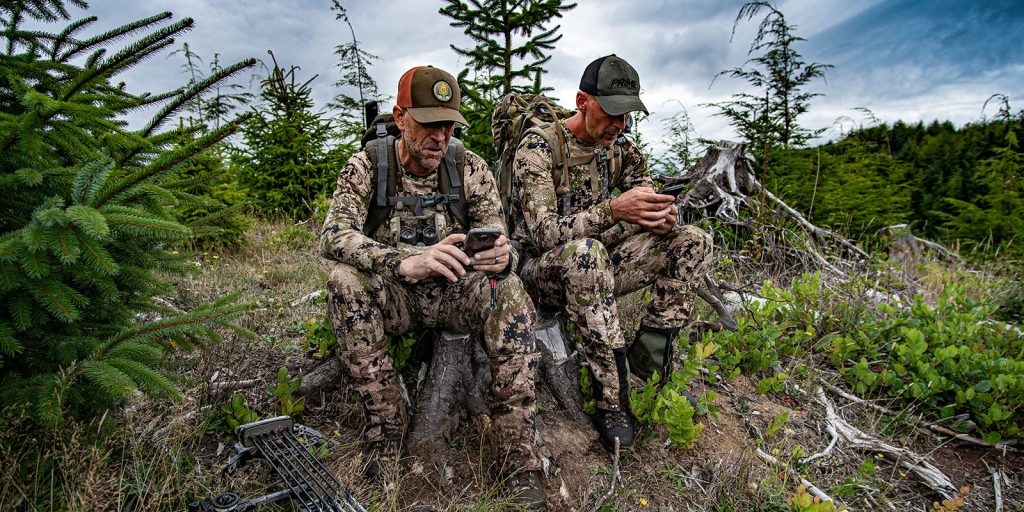
Knowing where you hit can help with the decision of how long to wait before you begin tracking. With a solid, double lung hit, back out and wait one hour. If the shot is too far back (guts), back out and wait at least three or four hours. There are a lot of factors that can come into play with these wait times; rain, snow, darkness, etc., but it is almost always better to hold off and find the elk bedded within the first 200 yards, rather than search for an elk that you end up bumping by trying to follow it immediately in adverse conditions.
FIRST BLOOD
The first phase of tracking will often yield the most clues about the task that lies ahead. However, it’s important to recognize that there might not be any blood for the first 30 to 100 yards, even with a good hit.
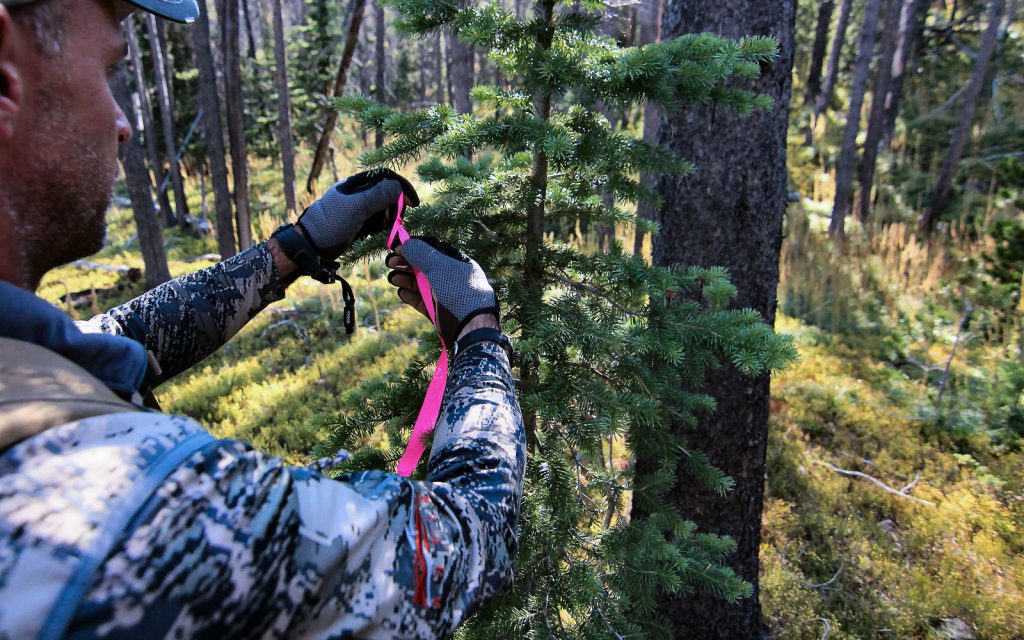
Elk will typically leave deep tracks and scuff marks in the ground as they flee after a shot. Having listened to the direction they fled after the shot will also provide a good idea of where to follow as you look for the first signs of a bloodtrail. Once you find first blood, hang another ribbon.
Blood is the key indicator that you have a confirmed hit, and can be very helpful in determining what kind of hit you actually have. The color, consistency, and quantity of blood will often provide much needed clues and help you decide whether to proceed or back out and wait longer.
The ideal shot will produce pink, foamy blood filled with lots of bubbles. This is evidence of a lung hit, which usually provides a fairly short and easy to follow bloodtrail. Bright, red blood without any bubbles, especially in larger quantities, typically signifies a muscle hit of some kind (heart, brisket, ham, etc.). A shot that is slightly high and back can produce limited amounts of dark red blood and would indicate a liver shot. Even farther back (paunch/guts) will produce a few drops of bright red blood at first, but usually won’t produce a very productive bloodtrail, especially after the initial hundred yards or so. Go back and read the previous chapter on Anatomy for more detailed analysis of the typical bloodtrail that is left by different shots.
FOLLOWING THE BLOODTRAIL
During all phases of tracking and following the bloodtrail, it is crucial to remain absolutely quiet. If the elk is still alive, making noise could scare the elk and cause a rush of adrenaline that can propel even the sickest of elk for several hundred yards – even miles. Additionally, a wounded, sick elk will often make noises that can be detected if you are quiet. Sounds such as heavy breathing, breaking branches, or coughing can give away the location of a wounded elk.
The ideal tracking job would include two hunters – one hunter in front to scour the ground for sign, and a second hunter following closely behind, watching ahead in the distance for a visual of the animal. It is easy to become so focused on following blood or tracks that a bedded elk might see you and get bumped before you even realize it is there. Jumping an elk at this point is BAD, and the chances of recovery go down dramatically. A third person makes the tracking job even better as they can wait at the location of last blood and help ribbon the trail as you go.
For bowhunters, it is usually during this phase of tracking that you are able to find the arrow. The arrow will provide additional clues regarding blood type and penetration. These clues may lead you to continue tracking, or to sit and wait a while longer.
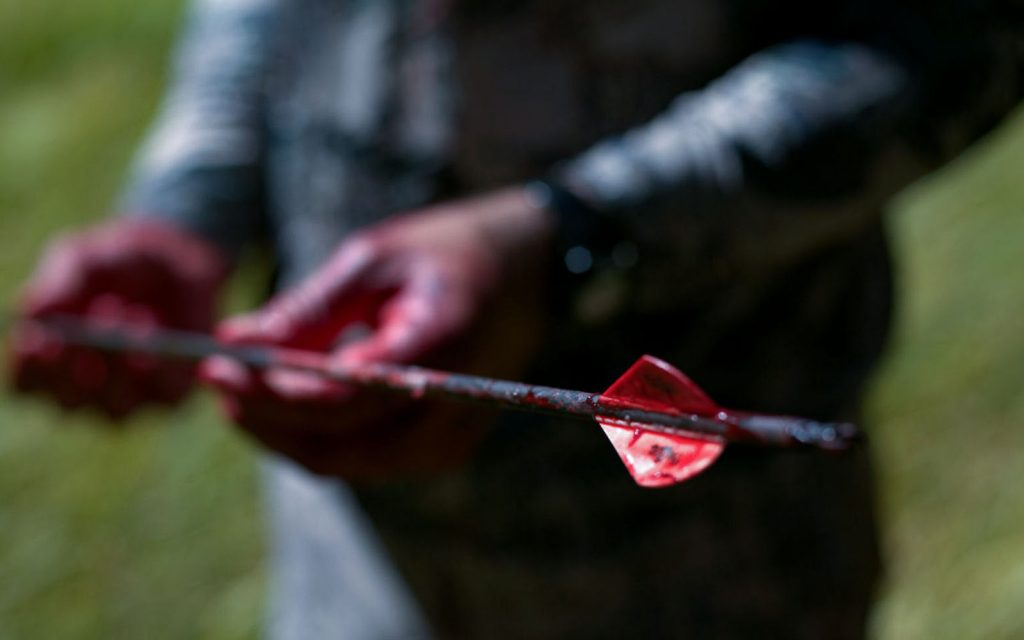
As you work along the bloodtrail, continue to hang flagging ribbon to mark the path. This will establish a course and direction of where the elk may be heading, and will be beneficial if the bloodtrail runs out.
Additionally, using a GPS during tracking can be incredibly helpful in establishing the direction an elk is travelling. A wounded elk will usually head for a specific area and not just be wandering aimlessly, and once they get lined out and head for that area, seeing the line of travel on a GPS can provide additional clues on where they are heading.
TRACKING
When a shot isn’t ideal, and even sometimes when it is, following the bloodtrail can turn into a hunt all of its own. During this phase, tracking skills and perseverance come to the surface. There are several key factors that can help an elk hunter when the bloodtrail gets tough.
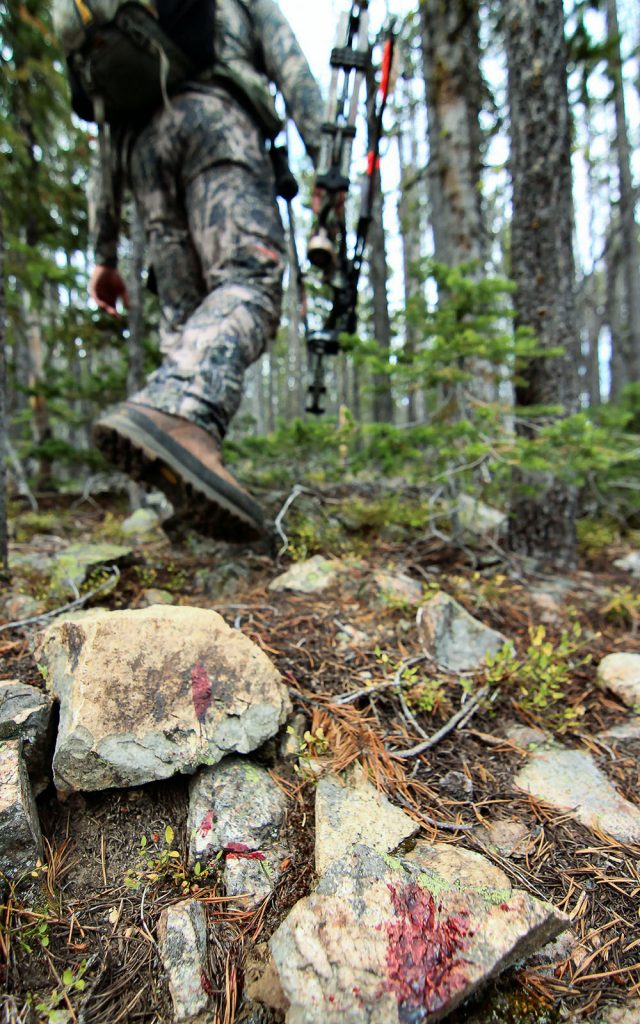
If you aren’t able to find your arrow, finding blood on brush or branches along the trail can help determine whether you had a pass-through (blood on both sides of the trail), or if your arrow is still in the animal (blood on one side only). Other clues, such as blood on high branches or seed-heads on tall grass can provide indications of whether the hit was high or low. If you’re finding the majority of the blood rubbed on higher branches/brush, keep looking for blood in these types of areas. Oftentimes, when an elk runs through brush and trees, the blood ends up on the underside of the branches and it requires turning them over for inspection. Look for blood in other obvious areas as well, such as where the elk crossed downed trees or rocks. These landmarks provide more contrast and make blood easier to spot.
Once an elk gets “lined out”, they’ll usually travel a fairly straight course as they retreat to cover (thick timber, cool draws, or vantage points). They will also often follow a path of least resistance if they haven’t been bumped. Having a trail of flagging ribbon (or marked on GPS) can help visualize that course and keep you moving in the right direction, even if the bloodtrail dies out and tracks become hard to distinguish.
Lastly, elk will rarely travel uphill when they are seriously injured. I use the word “rarely” very cautiously here, as I’ve seen elk go straight up a mountain even with a hard hit. If they do head uphill, it is usually for a limited distance, and often to get on a trail or bench, or to gain a vantage point. If you follow the trail uphill for a distance and the tracks or bloodtrail eventually veer to the side, that’s a good indicator the elk is hit hard. Once the elk turns and begins sidehilling, it’s also likely that it won’t gain more elevation and is looking for an area to bed down. Look for areas that an injured elk would likely go for safety in the near distance.
If the bloodtrail becomes hard to follow, have one person stay at the last spot of blood (or hang flagging ribbon if you’re tracking alone). Once another spot of blood is located, have the spotter move ahead to that location (or hang another ribbon).
You may go 100 yards or more without blood at this point, and having a spotter or ribbon at the last known location of blood will help bring you back to the right point to regroup without losing the trail completely. At this point, a single drop of blood will verify you’re still on the right trail and get you that much closer to your elk.
AT THE END OF THE BLOODTRAIL
When the bloodtrail ends completely, continue to follow tracks the best that you can. An injured elk will often make scuff marks in the dirt or drag its feet as it crosses downed logs. If the tracks become impossible to follow, stop and look for areas where an injured elk would most likely retreat to. Then, head in that direction in a straight line, looking closely for any signs that would indicate that you are still on the trail. Always make sure you have hung ribbon at the last confirmed blood or track so you can come back to that point if your search doesn’t provide additional confirmation.
Injured elk will often retreat to thick timber or brush patches, especially if those areas provide them with a thermal, visual, or audible advantage (smell, sight, sound). Cool, shady draws with water, or benches with a spring are another probable area to search for a wounded elk. The body’s natural immune response to injury causes an elevated body temperature, which will often drive a wounded elk to water or cool shade.
Another common area of retreat is an open ridge or knob that provides a visual vantage point. Elk are especially cautious when they are injured, and will often bed where they have the wind in their favor and/or where they are able to watch their backtrail, especially if they suspect they are being pursued (i.e., if you have previously jumped them). Always be mindful of the wind and be looking ahead as you follow the trail.
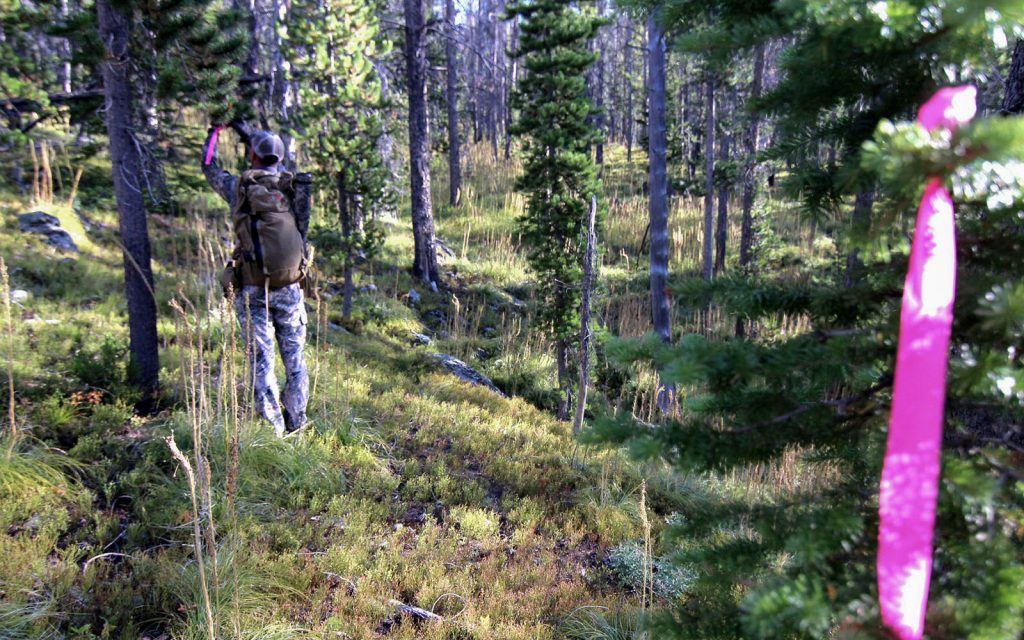
At this point in the process, it is easy to become mentally and physically exhausted. As badly as you want to keep going, it can be helpful to stop and rest. It is not beneficial to continue plowing blinding ahead. Be sure to replenish with food and water often and take breaks as you notice yourself getting careless. Tracking can be exhausting, and fatigue can make it easy to miss obvious sign or bump the elk. It is also at this point where many hunters give up. The frustration of not finding sign coupled with fatigue and discouragement can quickly lead to a feeling of hopelessness. Stop and take a break. If you need to, back all the way out and go back to camp. Get rest, or get more help. Fresh eyes and a fresh mind can breathe new life into a seemingly hopeless bloodtrail.
LAST RESORT
When all other options fail, and after scouring for sign for 4-6 hours, start a grid search from the last confirmed blood or track. Walk out 300-400 yards in a straight line, then drop down the hill 40 yards and parallel your way back to the last ribbon. Continue doing this, looking for signs of blood or tracks, as well as a downed elk. Then, repeat the process above the ribbon (or have your hunting partner grid search the area above the last blood as you search below).
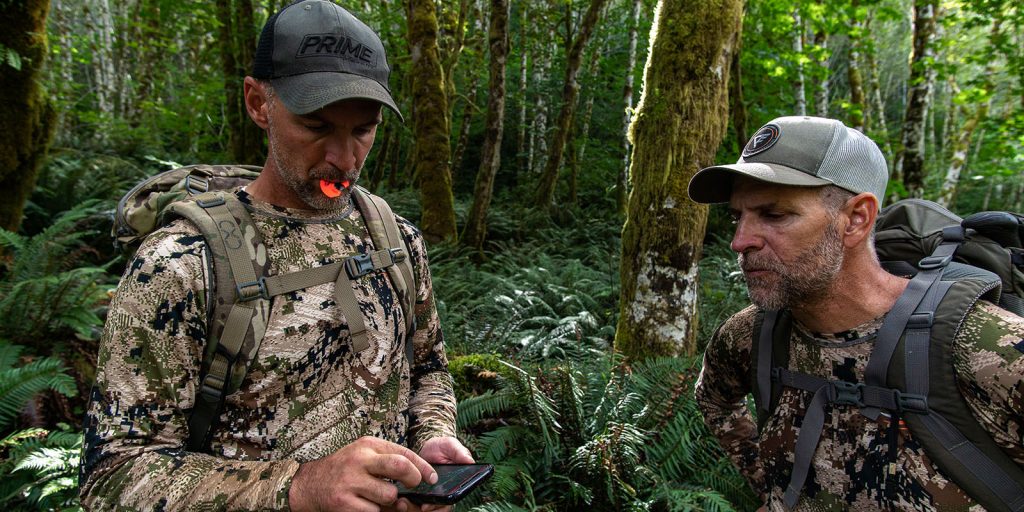
I can’t tell you how many times a bloodtrail has been abandoned, only to find the elk the next day or a few days later just a short distance from where the tracking job was terminated.
Using a GPS for the grid searches can help verify that you have covered the area sufficiently. A GPS will also give you an overview of the travel path the elk has taken thus far, and may provide additional clues as to where it is heading.
Only after an exhaustive search that includes investigating all probable bedding locations for an injured elk should you call it quits. At this point, there should be no doubt in your mind that the animal will survive.
If you suspect the hit was fatal and have done all you can to recover the elk, come back the next morning to listen for ravens and magpies. Ravens, vultures, and magpies will usually find a dead elk within 24 hours, especially in September and October, so come back and listen or watch for birds at daylight. Smell can also be a giveaway after 24 hours, so hiking downwind of suspected areas can also be productive in bringing closure to a hunt that’s gone awry.
SUMMARY
No one likes to lose an animal. We owe it to the animals we hunt and to the other sportsmen we share the mountains with to be as proficient as possible with our weapons. Still, things can and do happen that are out of our control. It’s our responsibility, and the law in most states, to make EVERY effort for recovery. Nothing can take the place of a high-percentage shot that we are confident in. However, when things go bad, tracking is a vital skill to learn to increase the chances of recovery.
Go slow. Be alert. Think like a wounded elk. Where would you go to get away and find safety and comfort? Watch for all clues (broken branches, obvious trails, tracks, scuff marks, hoof drags on downed logs, etc.), not just a trail of blood. While we should do everything possible to minimize the need for it when we take the shot, tracking can be the piece of the puzzle that ultimately separates failure and success.
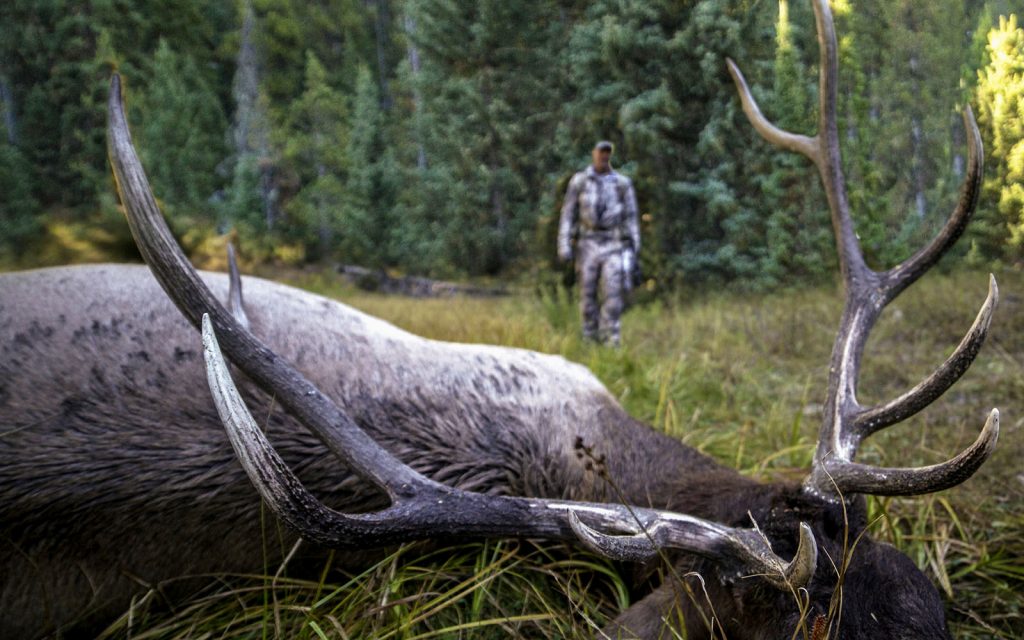
Hopefully, at the end of every bloodtrail there is reason for celebration. However, the successful recovery of an elk hardly indicates the end of the process. In fact, I’m sure you’ve heard the saying that, “The real work begins once you pull the trigger.” In order to complete the successful hunt, you will need to process the elk and pack it off the mountain.
Click ‘Next Module’ Below to Continue to the Module 13: Field Care of Elk Meat




